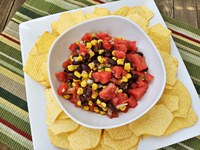Prairie Fare: July is National Picnic Month
(Click an image below to view a high-resolution image that can be downloaded)
Can you conjure up a memory of a recent or past picnic?
When I was very young, our family would pack the trunk of our old blue Impala sedan with lounger chairs, a camp stove and coolers full of food.
We left early in the morning for a state park, before the day became very hot. Our car did not have air conditioning, so we would roll down all the windows. Being the youngest, I sat in the center of the backseat. I am sure I had quite the “wind-swept” look upon arrival.
We’d find a couple of picnic tables under the trees within easy walking distance of the lake.
Besides the scenery, our entertainment consisted of a Frisbee and a game with large, heavy darts to throw toward a circle placed on the lawn.
While my parents cooked, I settled into one of the lounging chairs. The green webbing left imprints in my legs. I liked to lean back until the lounge chair “swallowed” my body like a plastic alligator.
Then I inevitably got caught with my lawn chair antics, I’d have to sit upright. I am surprised I didn’t get my hands caught in the chair mechanism.
I am more surprised that dart game didn’t cause an emergency room visit.
We would dine on burgers or steaks fried in a cast iron pan on a camp stove. Grills weren’t part of my early life. We usually had creamy potato salad, fresh lettuce and radishes from our garden, homemade buns, watermelon and homemade lemonade.
I can almost smell and taste the memory.
If you have enjoyed picnics, chances are you will remember the menu and good times associated with eating outside. Picnics have a long history and simply relate to bringing dining outdoors to enjoy nature’s scenery.
The word “picnic” dates back to the late 1600s, and may come from the French word “piquenique,” which first appeared in print in 1692.
In earlier times, picnics were events to celebrate a successful hunt. These fancy large feasts gave way to simpler meals in parks in the late 1700s.
By the 1800s, picnic tables were invented and looked similar to the modern-day wooden picnic tables. In 1952, the American Bakers’ Association launched National Picnic Month as an annual commemoration.
If you plan a picnic this year, remember these safety tips.
- Find out if your picnic destination has a source of safe drinking water. If not, bring water or moist towelettes for cleaning hands and surfaces.
- Be sure raw meat and poultry are wrapped securely to prevent their juices from cross-contaminating other foods in the cooler.
- Pack enough clean utensils for both eating and serving food. Don’t use the same utensil or platter for raw and cooked meat and poultry. Disposable plates and utensils help prevent cross-contamination.
- Keep foods covered to prevent insects from enjoying your lunch.
- Keep perishable foods cool by transporting them in an insulated cooler with plenty of ice or frozen gel packs. Perishable foods include meat, poultry, seafood, eggs, dairy products, pasta, rice, cooked vegetables, and fresh, peeled and cut fruits and vegetables.
- Pack the cooler just before leaving home. Foods chilling in your refrigerator should be placed directly in your cooler with ice or frozen gel packs.
- Bring a food thermometer to ensure that burgers reach 160 F and chicken reaches 165 F.
You can also pick up a picnic meal at a restaurant or grocery store, but be sure to keep cold foods cold. Foods such as washed whole fruit, peanut butter (or other nut butter) sandwiches, trail mix and cookies are nonperishable options.
July is National Picnic Month and National Watermelon Month. This fiber-rich, colorful salsa recipe would be a tasty side dish or dip for a picnic in the park. Like other perishable foods, keep the salsa cold on the way to and at the destination.
Watermelon, Black Bean and Corn Salsa
1 can corn kernels, rinsed and drained
1 can black beans, rinsed and drained
½ medium purple or white onion, coarsely chopped
1 to 2 jalapeno peppers, chopped
1 clove garlic, minced
1 teaspoon ground cumin
1 teaspoon chili powder
2 tablespoon salad oil (such as canola or olive)
1 lime, juiced
1½ cup watermelon, chopped (with seeds removed)
Optional ingredients: fresh chopped cilantro and diced cucumbers.
Mix all ingredients except watermelon. Gently fold in watermelon and chill. Serve with baked chips or as a side dish with grilled meat, poultry or fish.
Makes six servings. Each serving of dip has 130 calories, 5 grams (g) fat, 4 g protein, 21 g carbohydrate, 5 g fiber, and 160 milligrams sodium.
(Julie Garden-Robinson, Ph.D., R.D., L.R.D., is a North Dakota State University Extension food and nutrition specialist and professor in the Department of Health, Nutrition and Exercise Sciences. Follow her on Twitter @jgardenrobinson)
NDSU Agriculture Communication – July 6, 2023
Source: Julie Garden-Robinson, 701-231-7187, julie.garden-robinson@ndsu.edu
Editor: Elizabeth Cronin, 701-231-7881, elizabeth.cronin@ndsu.edu




